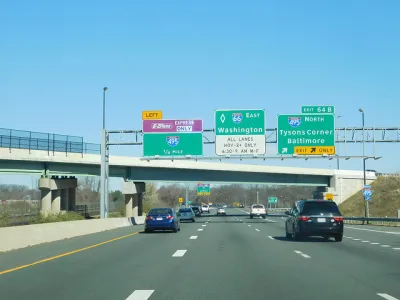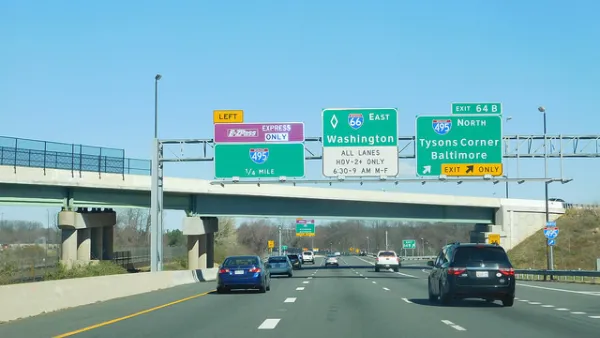Traffic speeds during the peak eastbound commute on the 66 Express Lanes Inside the Beltway have dropped to 35 mph. "Toll-tweaking" and changing the algorithm are achieving limited success on this dynamically-tolled stretch.

During commute hours, nine miles [png] of Interstate 66 in Northern Virginia, formerly known as the 66 Express Lanes Inside the Beltway, may operate like no other public roadway, let alone interstate, in the United States. During the morning restricted travel period from 5:30 a.m to 9:30 a.m., all (two to three) eastbound lanes are dynamically priced—there are no adjacent general purpose lanes for single-occupant vehicles (SOVs) to take to avoid paying a toll, which, on occasion, top $40.
The afternoon restricted travel period extends from 3 p.m. to 7 p.m. on all the westbound lanes. Once again, no "free lane" to choose if you lack a passenger.
The uncapped, dynamic tolling makes the roadway stand out as an example of how effective congestion or value pricing is at reducing congestion, encouraging modal alternatives, and funding public transit with toll revenues.
The operator of these time-restricted, high-occupancy toll (HOT) lanes, the Virginia Department of Transportation, is trying, perhaps paradoxically, to reduce the tolls and, at the same time, increase the speed, during the most congested part of the commute hour, from 8:15 a.m to 8:30 a.m, "when average speeds in April slowed below 35 mph," reports Max Smith for WTOP News on June 8. The roadway is unique for another reason: the low number of commute-hour SOVs.
About two-thirds of the vehicles on the road at that time are riding free — motorcycles, buses, and cars carrying at least two people with an E-ZPass Flex switched to HOV mode. Speeds in the morning remained slower than the same period a year earlier between 7:30 a.m. and 9:15 a.m.
While one way to deal with the slowdowns around 8:30 a.m. could be to raise tolls even higher as speeds significantly slow at that time, Virginia Transportation Secretary Shannon Valentine hopes changes to the tolling algorithm, along with better communication to commuters, could provide a different path if drivers change how they commute to either carpool, take the bus or go in at a different time.
It is somewhat ironic that an interstate highway that takes workers to the seat of American government would be one of the best examples in the country of applying market forces to auto travel.
“Because this is a true dynamic tolling system where people are making decisions in the moment based on the cost, it is true capitalism. … If we mandate certain limits, we can’t adjust it,” Valentine said.
Hat tip to AASHTO Daily Transportation Update.
FULL STORY: I-66 toll fix could urge you to wake up earlier

National Parks Layoffs Will Cause Communities to Lose Billions
Thousands of essential park workers were laid off this week, just before the busy spring break season.

Retro-silient?: America’s First “Eco-burb,” The Woodlands Turns 50
A master-planned community north of Houston offers lessons on green infrastructure and resilient design, but falls short of its founder’s lofty affordability and walkability goals.

Delivering for America Plan Will Downgrade Mail Service in at Least 49.5 Percent of Zip Codes
Republican and Democrat lawmakers criticize the plan for its disproportionate negative impact on rural communities.

Test News Post 1
This is a summary

Test News Headline 46
Test for the image on the front page.

Balancing Bombs and Butterflies: How the National Guard Protects a Rare Species
The National Guard at Fort Indiantown Gap uses GIS technology and land management strategies to balance military training with conservation efforts, ensuring the survival of the rare eastern regal fritillary butterfly.
Urban Design for Planners 1: Software Tools
This six-course series explores essential urban design concepts using open source software and equips planners with the tools they need to participate fully in the urban design process.
Planning for Universal Design
Learn the tools for implementing Universal Design in planning regulations.
EMC Planning Group, Inc.
Planetizen
Planetizen
Mpact (formerly Rail~Volution)
Great Falls Development Authority, Inc.
HUDs Office of Policy Development and Research
NYU Wagner Graduate School of Public Service




























